How to Make an Uplifting Herbal Tea For Mental Health
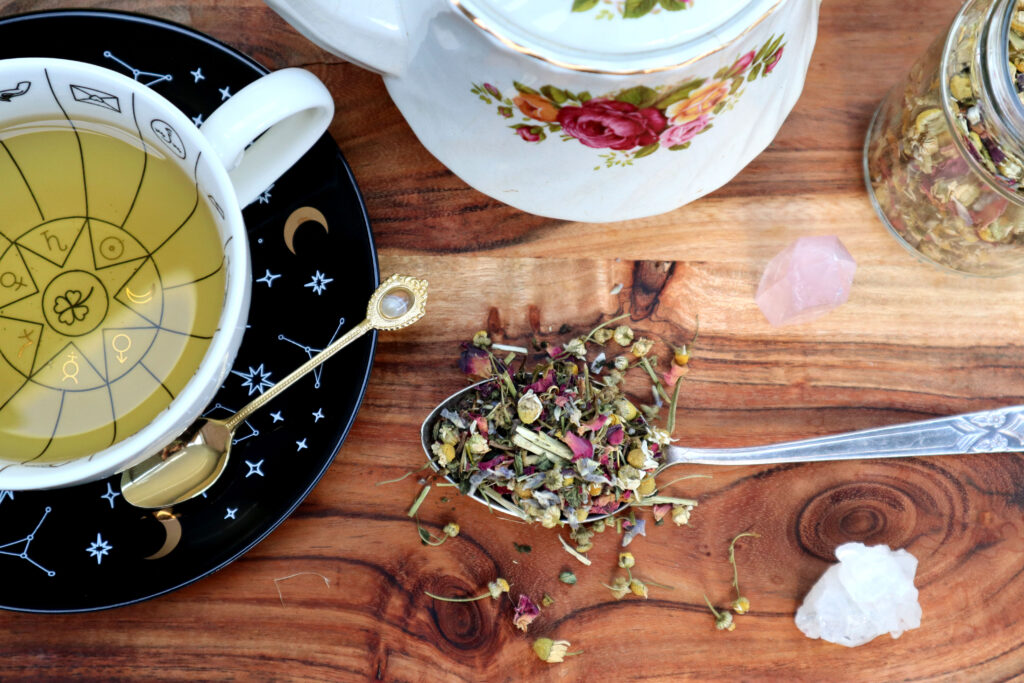
I’m so happy to be sharing the recipe for my Uplifting Herbal Tea Blend with you today!
This is my favourite recipe for tough times and trauma processing. I developed it intuitively a couple of years ago when I was teaching myself herbalism. This tea has gotten us through some really tough times. Stres, grief, trauma processing, you name it. It’s an invaluable staple in my home apothecary.
I generally don’t premix any batches of tea aside from my Nervous and Immune System Balancing Tea. That’s only because it has ten separate ingredients and we drink it first thing every single morning. I love slow living and all….but ain’t nobody got time for that! I tend to just mix tea blends straight into the teapot. But I always have some Uplifting Herbal Tea made up. I keep it ready to go, in case of nervous system emergencies.
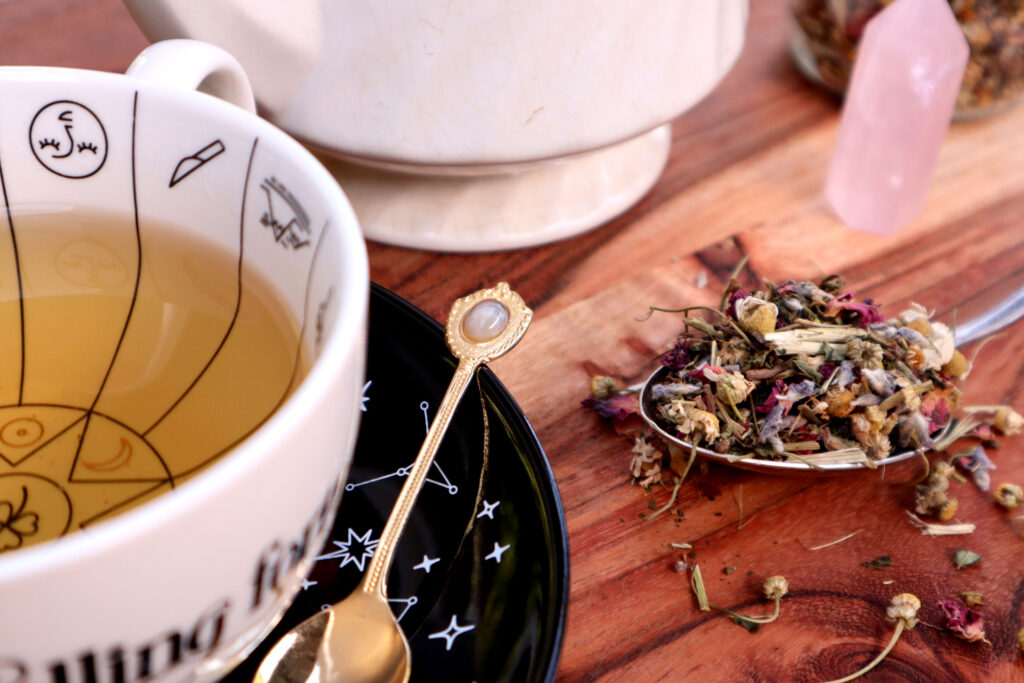
How does this Uplifting Herbal Tea Help with Depression, Anxiety and Trauma?
At home I sometimes call this blend Valium Tea. It doesn’t contain any Valium, obviously. It does contain potent herbal muscle relaxants, sedatives and tranquilisers. As someone who has used Valium for severe muscle spasticity, I think the effects are somewhat comparable to lower dose Valium.
The key difference is that the tea contains no habit forming and potentially dangerous pharmaceutical ingredients. You don’t need a prescription from a doctor, and the ingredients are easily accessible and inexpensive. Or potentially even free if you have a garden or a good friend who does!
This tea is perfect to have on hand for when sh*t happens. It helps immensely to calm you down in times of high stress, anxiety and trauma. It relieves stress, nervous tension and irritability. If you drink it about an hour before bed, it really helps to relieve insomnia.
Uplifting Herbal Tea can assist with Trauma Processing
It also contains ingredients which help to lift your mood, ease depression, open the heart, and cultivate patience, self-love and forgiveness. This is crucial for trauma processing and integration, especially after the fact. It is especially good for for complex and repressed trauma, which makes it the perfect accompaniment to Shadow Work practices.
See my article on Shadow Work for more information and my free Shadow Work Journal Prompts Printable. If you have any kind of trauma, mental illness, or chronic health issues, you should give Shadow Work a try. Even if you don’t think you have any of these issues, I believe that everyone can benefit from Shadow Work.
I also highly recommend using this tea as part of a Healing Tea Ritual for maximum effectiveness. When using this tea as part of the ritual, you can use the action of stirring the tea to help you to release trauma and that which no longer serves you, and create space for healing and new growth.
Caution and disclaimer
My Uplifting Herbal Tea Blend is a pretty potent relaxation aid. I do NOT recommend driving or operating machinery after drinking it, unless you know exactly how it affects you. It’s also NOT safe to use if you’re already taking pharmaceutical or herbal sleep aids, sedatives or muscle relaxant medications. You also shouldn’t combine it with blood thinning medications, as this could potentially cause bleeding.
I am not a licenced medical doctor, nor am I a qualified herbalist. This is simply a tea recipe, this post is not designed to diagnose or treat specific medical conditions. These ingredients are generally very safe, but always discuss with a trusted medical practitioner. Especially if you have a diagnosed medical condition, are taking other supplements or medications, have any concerns about the ingredients, or are pregnant.
If you have Mast Cell Activation Syndrome or have a lot of random allergic reactions to different things, my Nervous and Immune System Balancing Tea Recipe has more information on skin patch testing and how to gradually add ingredients to tea recipes to reduce the risk of allergic reactions.
Uplifting Herbal Tea Blend Ingredients
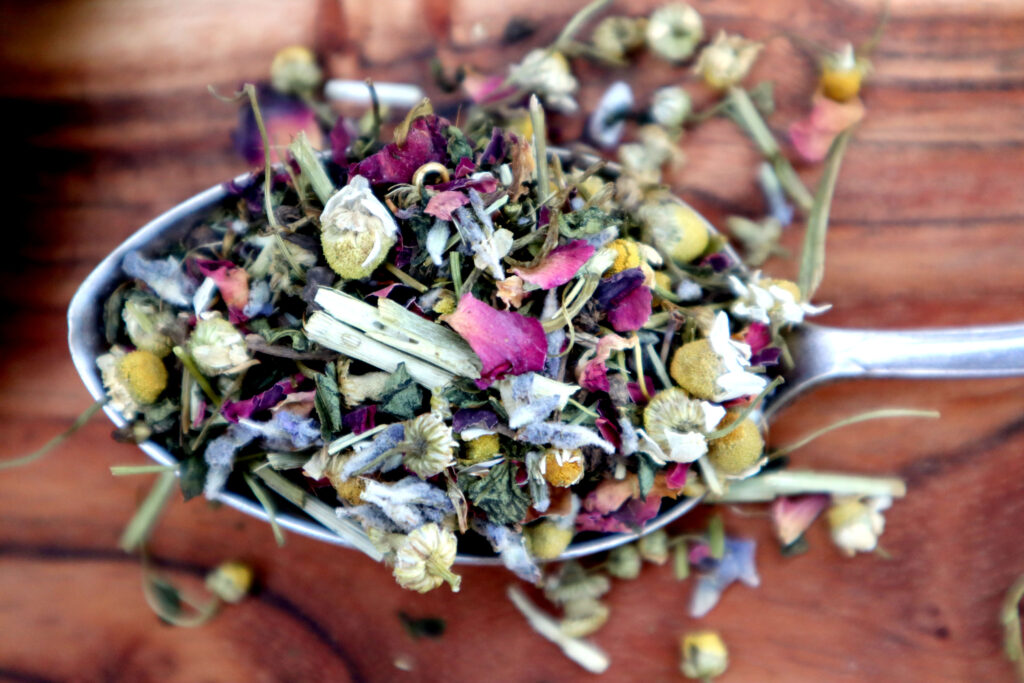
A note on herbs
Be picky about your supplier
Before we dive into the ingredients, it’s important to mention that you should always try to opt for quality organic teas and dried herbs when possible. You don’t want to be adding pesticides or chemical fertilizers to your healing tea! In Australia, I’ve found Tea Life and Wildcraft Dispensary to generally be good suppliers. Mountain Rose Herbs in the USA seem to have a great reputation with herbalists.
Try growing some of your own
With that said, I also strongly recommend that if you work with this tea, you consider growing, harvesting and drying some of these herbs. NOTHING compares to the healing energy of herbs you have tended, harvested, dried and prepared for yourself. Connecting with plants and nature is the greatest healer of all. I grow most of my own lemon balm, chamomile, lavender and Rose petals for this tea.
Ingredients
Chamomile (Matricaria recutita)
Chamomile flowers are beautifully soothing and calming to the nervous system. They help to relax muscles and promote sleep.
Caution: those with ragweed allergies may have an allergic reaction to Chamomile. Do NOT use chamomile if you are taking any kind of blood thinning medication, aspirin etc. Chamomile is a mild blood thinner, mixing it with other blood thinners may cause bleeding.
Passionflower (Passiflora Incarnata)
The aerial parts of the passionfruit vine are used as a gentle, yet effective and non-addictive sedative, tranquilliser and muscle relaxant. Passionflower helps with anxiety, insomnia, tension and irritability. This makes it perfect for calming a hypervigilant or dysregulated nervous/immune system.
Caution: passionflower can cause drowsiness. Do not take high doses in pregnancy.
Lavender (Lavandula species)
Lavender works as a muscle relaxant and improves depression, anxiety and insomnia.
It is also antimicrobial, antibacterial, antifungal and neuroprotective, which means it can protect the body from nerve damage.
It also helps to heal existing nerve damage, which is important in healing the nervous system dysregulation caused by trauma.
Rose (Rosa Centifolia)
Rose helps to ease depression. It opens the heart and helps us to reconnect with our feelings, our body, and our inner child.
Rose helps us to develop self-love, compassion and forgiveness. It helps our body eliminate waste products, which is the physical part of the process of releaseing old wounds and patterns. Rose is a beautiful herbal ally for working through repressed complex trauma with Shadow Work practices.
Lemon Balm (Melissa officianalis)
Lemon Balm is a relaxant and antispasmodic. The fresh lemony scent is guaranteed to uplift. It works as a nerve tonic, which calms the central nervous system, and can ease anxiety, mild depression, restlessness and irritability. Lemon Balm reduces nervousness and panic, as well as heart palpitations and digestive issues caused by anxiety or stress. It was traditionally used to lift the spirits and promote longevity.
Caution: Lemon Balm inhibits thyroid function, so if you have thyroid issues, you should discuss with a trusted medical professional whether or not this plant medicine is right for you.
I had a combination of hypo and hyper symptoms, caused by a bad reaction to T3 hormones (straight T4 was much better). Regulating my Nervous/Immune system with Shadow Work has meant that my thyroid function is stable without medication (which my doctors and I believed I’d be on for the rest of my life). I now use lemon balm often (especially during the warmer months) and do not experience any thyroid issues, but every body is different.
Valerian (Valeriana officianalis)
Valerian is a powerful non-addictive sedative and antispasmotic. It is excellent for relieving the muscle spasticity which accompanies stress, anxiety and trauma, and aiding in sleep. It can have a very strong flavour in tea, so I only use a 1/2 part in this recipe. If you’re using this tea specifically for insomnia, you may want to increase to 1 part.
Obviously, it can cause drowsiness (that’s the point!), so use with caution and don’t drive or anything until you understand how it affects you.
How to make Uplifting Herbal Tea
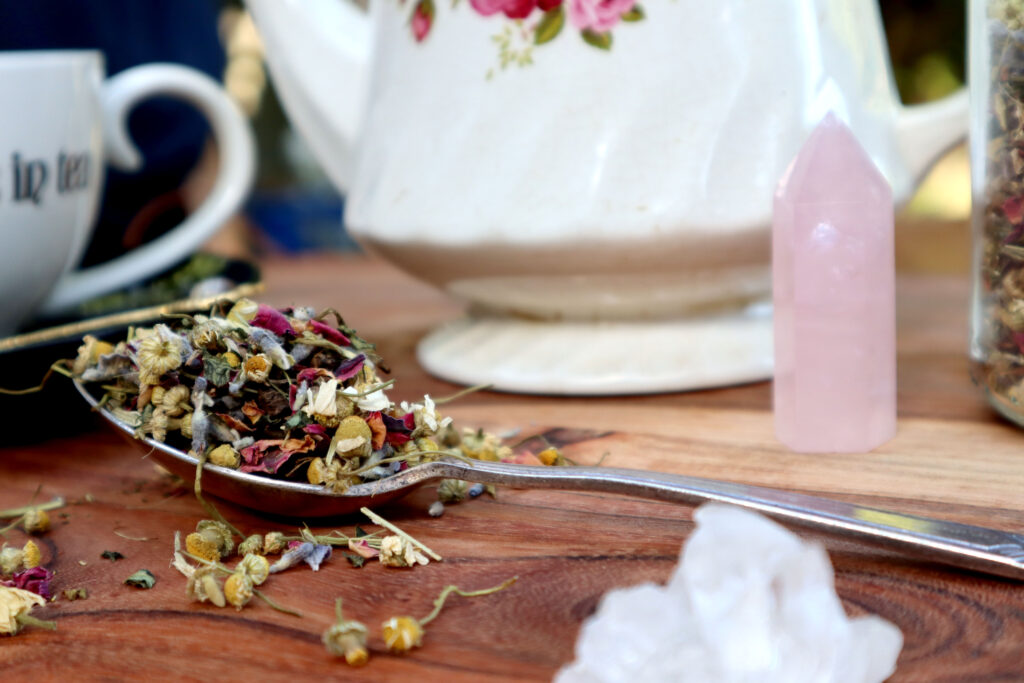
3 parts dried Chamomile flowers
2 parts dried Passionflower aerial parts, chopped or crumbled
1 part dried Lavender flowers, crumbled
1 part dried red Rose petals, crumbled
1 part dried Lemon Balm leaves, crumbled
½ part dried Valerian root, chopped into small pieces
Making the Tea
Obviously you can stop reading here, simply combine the above ingredients in a clean recycled jar or container, and be done with it. If you choose to do this though, you’re missing a trick. The herbs will still help you, but only passively. However, if you ask the spirits of the herbs to help heal you (in a basic ritualised setting, outlined below), they can actively help you to heal.
Since this is a powerful Healing Tea, I believe it’s important to give it the respect it deserves and to focus your energy on gratitude and healing as you are collecting and combining ingredients.
Make sure your work surface and tools (spoon or scoop for measuring, recycled jar/container) are clean and your hands are washed and dried. Gather your tools and ingredients. Try to minimise potential distractions where possible.
Getting into a meditative state
Sit down and take a few moments (or minutes – however long it takes) to breathe deeply, ground and centre yourself. Try to clear your mind of stress and worry, and enter into a calm and receptive meditative state. If you’re not quite sure how to do this, read my article on grounding techniques.
It’s very important that you do not hold any anger or resentment in your heart during this process, as these emotions prevent and delay healing. Hold this calm, open state as you prepare your batch of tea.
Take your time to measure out your ingredients one by one. Place them into a clean recycled glass jar or other airtight container (preferably not plastic).
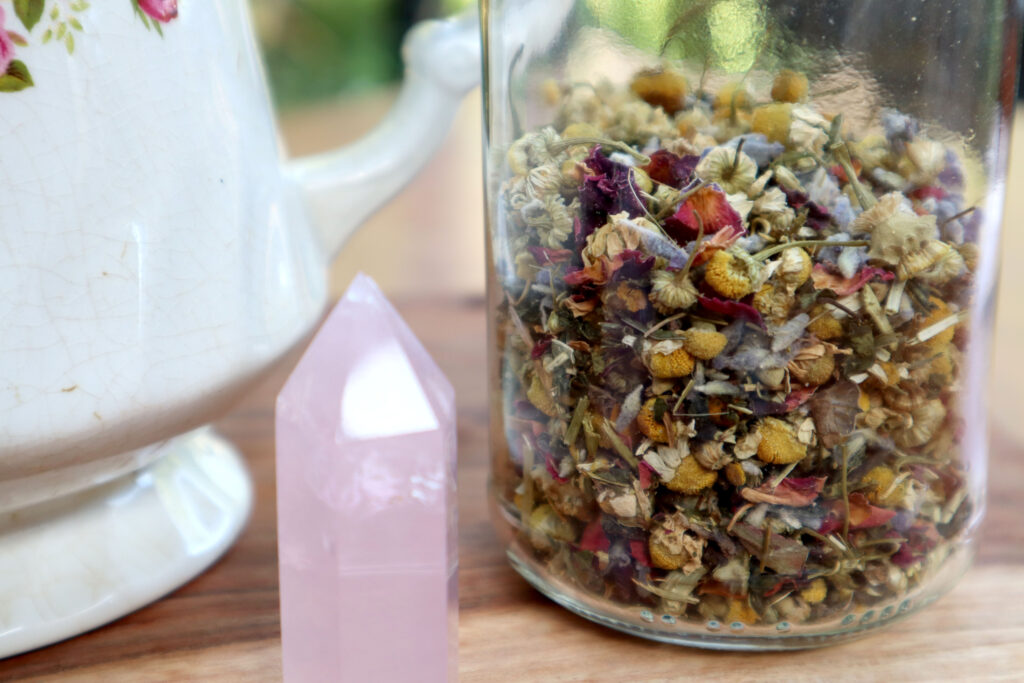
Adding your intention
When you have all your ingredients in your tea jar or container, you can start to actively add your intention and respectfully ask the herbs to heal you.
This probably sounds silly or crazy to people who have never spoken to plants, but I promise they can hear you and feel your intention.
Humans have evolved alongside plant medicine since the dawn of man, we are designed to work together (unlike humans and most pharmaceuticals).
Regardless of your skin colour, gender, race or religion, at some point in time, your ancestors used plant medicines and shamanic techniques to work with their healing energies. It is your birthright to connect with the healing energies of nature and the practices of your ancestors. Despite what organised religion and its societal constructs may tell you.
Project your energy
You can either stir with a spoon or gently shake (with the lid on) your jar or container to distribute and combine the herbs. As you do this, express your gratitude and respectfully ask the herbs to help you to heal. You don’t need to do this out loud if you don’t want to, just focus on projecting your thoughts and energy.
I usually (energetically not vocally) say something along the lines of “Dear herbs, thank you for sharing your beautiful energy. Please help us to heal and be healthy and strong. Please help us to release old trauma and that which no longer serves us, to create space for healing and new growth. Thank you, my friends”.
This is just what feels right to me, but you should say whatever feels right to you.
It doesn’t need to rhyme or anything fancy, just be sincere and ask for what you need help with. You don’t even need to form specific words, as long as you are expressing your feelings of gratitude and intention for release and healing.
Whenever you feel that your message has been received, the tea is ready to use. Preferably in a Healing Tea Ritual or as an accompaniment to Shadow Work.
I like to serve mine with a spoonful of raw local honey because the sweetness helps cultivate self-love (and I just love honey!), but it also tastes nice on it’s own. I recommend using one heaped teaspoon of tea per cup of boiled water.
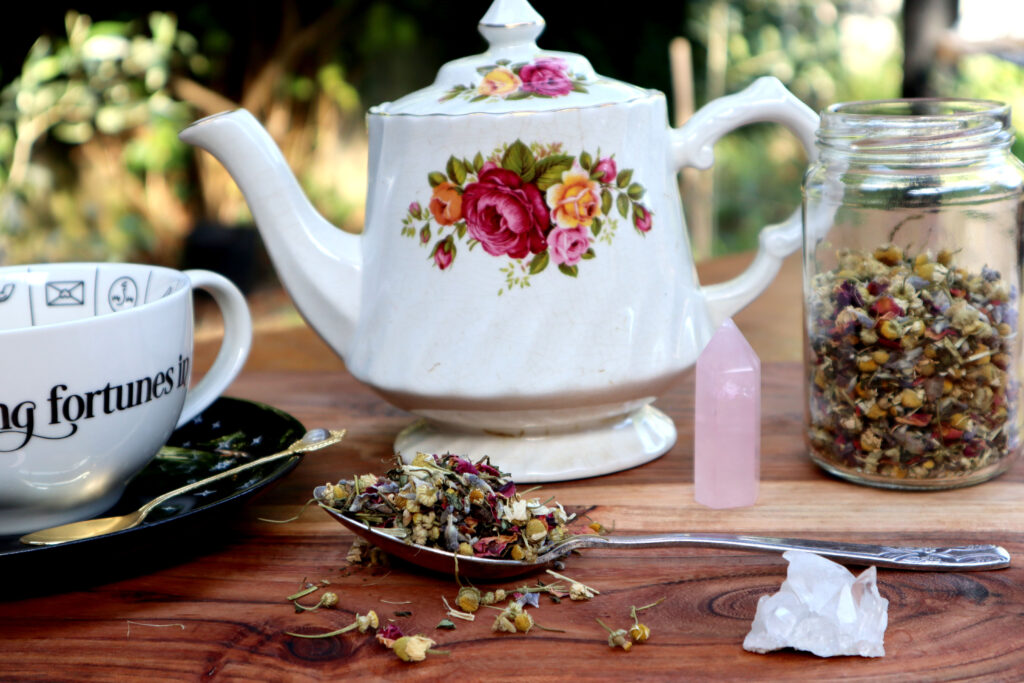
There you have it! I hope you give this beautiful tea a try. Let me know in the comments section if you have tried my Uplifting Herbal Tea, and if you found it helpful.
Happy Tea Making!
[optin-monster-inline slug=”qdfs5cowsxbtmmucnrtm”]